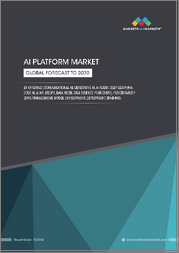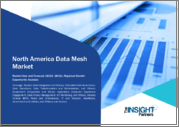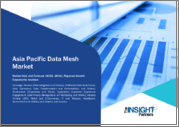
|
시장보고서
상품코드
1497708
데이터 메시 시장 점유율 : 제공, 비즈니스 기능, 어프로치, 용도, 산업별 - 세계 매출 추산과 수요 예측(-2030년)Data Mesh Market Share Report by Offering, Business Function, Approach, Application, Vertical - Global Industry Demand Forecast to 2030 |
||||||
세계의 데이터 메시 시장 규모는 2023년 12억 9,040만 달러에서 예측 기간 중 CAGR 16.9%로 추이하며, 2030년에는 37억 9,430만 달러 규모로 성장할 것으로 예측됩니다. 데이터 민주화와 가용성에 대한 요구의 증가가 이 업계 확대의 주요 이유입니다.
시장 인사이트 :
지역별로는 북미가 40%의 점유율로 업계 선두를 달리고 있습니다. 이 지역의 여러 기업이 데이터 메시 기술을 수용하고 복잡한 데이터 문제를 해결할 수 있는 잠재력을 인식하고 있습니다. 전문 플랫폼과 이러한 원칙에 부합하는 툴이 등장하고 있는 것이 주요 트렌드입니다. 이러한 솔루션은 분산형 데이터 아키텍처를 제공하여 서로 다른 도메인 및 팀 간의 원활한 통합, 접근성 및 거버넌스에 도움이 됩니다.
비즈니스 기능별로는 인사 부문이 10년간 CAGR 18%로 성장할 것으로 예상됩니다. 이는 직원 중심 프로그램에 대한 관심이 높아지고 있기 때문입니다. 인사 부서는 이러한 시스템을 활용하여 성과 통계, 직원 참여도 측정, 기술 인벤토리 등 다양한 전자 데이터 소스의 복잡성을 관리하고 있습니다.
헬스케어 및 생명과학 분야는 10년 동안 17%라는 가장 빠른 속도로 성장할 것으로 예상됩니다. 이는 주로 환자 기록, 연구 정보, 게놈 데이터 등 의료 정보의 양이 증가하고 있기 때문입니다.
세계의 데이터 메시 시장을 조사했으며, 시장의 정의와 개요, 시장 영향요인의 분석, 시장 규모의 추이·예측, 각종 구분·지역/주요 국가별 상세 분석, 경쟁 환경, 주요 기업의 개요 등을 정리하여 전해드립니다.
목차
제1장 조사 범위
제2장 조사 방법
제3장 주요 요약
제4장 시장 지표
제5장 업계 전망
- 시장 역학
- 동향
- 촉진요인
- 억제요인·과제
- 촉진요인·억제요인의 영향 분석
- COVID-19의 영향
- Porter's Five Forces 분석
제6장 세계 시장
- 개요
- 시장 매출의 추이·예측 : 제공별
- 시장 매출의 추이·예측 : 비즈니스 기능별
- 시장 매출의 추이·예측 : 용도별
- 시장 매출의 추이·예측 : 산업별
- 시장 매출의 추이·예측 : 국가별
제7장 북미 시장
제8장 유럽 시장
제9장 아시아태평양 시장
제10장 라틴아메리카 시장
제11장 중동 및 아프리카 시장
제12장 미국 시장
제13장 캐나다 시장
제14장 독일 시장
제15장 프랑스 시장
제16장 영국 시장
제17장 이탈리아 시장
제18장 스페인 시장
제19장 일본 시장
제20장 중국 시장
제21장 인도 시장
제22장 호주 시장
제23장 한국 시장
제24장 브라질 시장
제25장 멕시코 시장
제26장 사우디아라비아 시장
제27장 남아프리카공화국 시장
제28장 UAE 시장
제29장 경쟁 구도
- 주요 기업·제품 리스트
- 주요 기업의 경쟁 벤치마킹
- 주요 기업의 제품 벤치마킹
- 최근 전략적 개발
제30장 기업 개요
- IBM Corporation
- Amazon Web Services Inc.
- SAP SE
- Oracle Corporation
- Informatica Inc.
- K2view Ltd.
- Talend Inc.
- Denodo Technologies Inc
- Hewlett Packard Enterprise Company
- NetApp Inc.
- Teradata Corporation
- Radiant Logic Inc.
- Snowflake Inc.
- Google LLC
- Microsoft Corporation
제31장 부록
KSA 24.06.26Key Highlights
The data mesh market was valued at USD 1,290.4 million in 2023, and it will increase to USD 3,794.3 million, propelling at a 16.9% compound annual growth rate, by 2030.
The increasing need for data democratization as well as availability is a key reason for the expansion of this industry.
Inside the data mesh design system, this demand suggests a move toward providing various partners across an association secure and reliable access to important data.
By democratizing digital data, associations abolish traditional storehouses, thus refining a culture in which various groups can independently obtain, understand, and influence data appropriate to their targets and jobs.
This method allows harmonized efforts and enhances the decision-making procedures by allowing fast access to contextualized and continuous data.
The industry is also powered by the surging need of businesses for innovation, informed decision-making, and flexibility.
The idea of federated computational governance offers a large opportunity in the continuously developing field of data mesh architecture.
It results in a key change in the approach businesses handle and oversee their distributed electronic data. This approach mirrors a decentralized model, where management is distributed among various areas inside an organization.
Market Insights
North America is leading the industry, with a 40% share. Several businesses in the continent are accepting the data mesh technology, realizing its potential to address complex data challenges.
The arrival of specialized platforms, as well as tools tailored to these principles, is a substantial trend.
These solutions offer decentralized data architectures, which are helpful for seamless incorporation, accessibility, and governance across different domains and teams.
The U.S. is the largest contributor to the industry in North America, owing to the fact that the nation is ahead in terms of technological development.
The human resources category will advance at an 18% CAGR during this decade.
This is because of the increasing focus on employee-centric programs, which necessitate more customization and greater consciousness of workforce info.
HR departments are utilizing these systems to manage the complexity of various electronic data sources like performance statistics, worker engagement measures, and skills inventories.
The healthcare and life science category will propel at the fastest rate, of 17%, during this decade.
This is primarily because of the increasing volume of healthcare information, such as patient records, research information, and genomic data.
Enhanced incorporation and analysis across different data sources are allowed by the decentralized structure of the data mesh for various domains in the healthcare & life sciences.
The fine-grained method will advance at a 15% compound annual growth rate in the years to come. This method emphasizes granular and complex data management, which allows for meeting the rising requirements of associations for definite and exact data control.
Data diversity and complexity are rising continuously, which, along with the need for further data handling at miniature levels, boosts the industry.
The industry is observing a dynamic competitive landscape, with businesses competing to profit from the growing interest in decentralized data structures.
Many key companies are enhancing their services, tools, and platforms to streamline the procedure of employing these principles.
Table of Contents
Chapter 1. Research Scope
- 1.1. Research Objectives
- 1.2. Market Definition
- 1.3. Analysis Period
- 1.4. Market Size Breakdown by Segments
- 1.4.1. Market size breakdown, by offering
- 1.4.2. Market size breakdown, by business function
- 1.4.3. Market size breakdown, by approach
- 1.4.4. Market size breakdown, by application
- 1.4.5. Market size breakdown, by vertical
- 1.4.6. Market size breakdown, by region
- 1.4.7. Market size breakdown, by country
- 1.5. Market Data Reporting Unit
- 1.5.1. Value
- 1.6. Key Stakeholders
Chapter 2. Research Methodology
- 2.1. Secondary Research
- 2.1.1. Paid
- 2.1.2. Unpaid
- 2.1.3. P&S Intelligence database
- 2.2. Primary Research
- 2.3. Market Size Estimation
- 2.4. Data Triangulation
- 2.5. Currency Conversion Rates
- 2.6. Assumptions for the Study
- 2.7. Notes and Caveats
Chapter 3. Executive Summary
Chapter 4. Market Indicators
Chapter 5. Industry Outlook
- 5.1. Market Dynamics
- 5.1.1. Trends
- 5.1.2. Drivers
- 5.1.3. Restraints/challenges
- 5.1.4. Impact analysis of drivers/restraints
- 5.2. Impact of COVID-19
- 5.3. Porter's Five Forces Analysis
- 5.3.1. Bargaining power of buyers
- 5.3.2. Bargaining power of suppliers
- 5.3.3. Threat of new entrants
- 5.3.4. Intensity of rivalry
- 5.3.5. Threat of substitutes
Chapter 6. Global Market
- 6.1. Overview
- 6.2. Market Revenue, by Offering (2017-2030)
- 6.3. Market Revenue, by Business Function (2017-2030)
- 6.4. Market Revenue, by Approach (2017-2030)
- 6.5. Market Revenue, by Application (2017-2030)
- 6.6. Market Revenue, by Vertical (2017-2030)
- 6.7. Market Revenue, by Region (2017-2030)
Chapter 7. North America Market
- 7.1. Overview
- 7.2. Market Revenue, by Offering (2017-2030)
- 7.3. Market Revenue, by Business Function (2017-2030)
- 7.4. Market Revenue, by Approach (2017-2030)
- 7.5. Market Revenue, by Application (2017-2030)
- 7.6. Market Revenue, by Vertical (2017-2030)
- 7.7. Market Revenue, by Country (2017-2030)
Chapter 8. Europe Market
- 8.1. Overview
- 8.2. Market Revenue, by Offering (2017-2030)
- 8.3. Market Revenue, by Business Function (2017-2030)
- 8.4. Market Revenue, by Approach (2017-2030)
- 8.5. Market Revenue, by Application (2017-2030)
- 8.6. Market Revenue, by Vertical (2017-2030)
- 8.7. Market Revenue, by Country (2017-2030)
Chapter 9. APAC Market
- 9.1. Overview
- 9.2. Market Revenue, by Offering (2017-2030)
- 9.3. Market Revenue, by Business Function (2017-2030)
- 9.4. Market Revenue, by Approach (2017-2030)
- 9.5. Market Revenue, by Application (2017-2030)
- 9.6. Market Revenue, by Vertical (2017-2030)
- 9.7. Market Revenue, by Country (2017-2030)
Chapter 10. LATAM Market
- 10.1. Overview
- 10.2. Market Revenue, by Offering (2017-2030)
- 10.3. Market Revenue, by Business Function (2017-2030)
- 10.4. Market Revenue, by Approach (2017-2030)
- 10.5. Market Revenue, by Application (2017-2030)
- 10.6. Market Revenue, by Vertical (2017-2030)
- 10.7. Market Revenue, by Country (2017-2030)
Chapter 11. MEA Market
- 11.1. Overview
- 11.2. Market Revenue, by Offering (2017-2030)
- 11.3. Market Revenue, by Business Function (2017-2030)
- 11.4. Market Revenue, by Approach (2017-2030)
- 11.5. Market Revenue, by Application (2017-2030)
- 11.6. Market Revenue, by Vertical (2017-2030)
- 11.7. Market Revenue, by Country (2017-2030)
Chapter 12. U.S. Market
- 12.1. Overview
- 12.2. Market Revenue, by Offering (2017-2030)
- 12.3. Market Revenue, by Business Function (2017-2030)
- 12.4. Market Revenue, by Approach (2017-2030)
- 12.5. Market Revenue, by Application (2017-2030)
- 12.6. Market Revenue, by Vertical (2017-2030)
Chapter 13. Canada Market
- 13.1. Overview
- 13.2. Market Revenue, by Offering (2017-2030)
- 13.3. Market Revenue, by Business Function (2017-2030)
- 13.4. Market Revenue, by Approach (2017-2030)
- 13.5. Market Revenue, by Application (2017-2030)
- 13.6. Market Revenue, by Vertical (2017-2030)
Chapter 14. Germany Market
- 14.1. Overview
- 14.2. Market Revenue, by Offering (2017-2030)
- 14.3. Market Revenue, by Business Function (2017-2030)
- 14.4. Market Revenue, by Approach (2017-2030)
- 14.5. Market Revenue, by Application (2017-2030)
- 14.6. Market Revenue, by Vertical (2017-2030)
Chapter 15. France Market
- 15.1. Overview
- 15.2. Market Revenue, by Offering (2017-2030)
- 15.3. Market Revenue, by Business Function (2017-2030)
- 15.4. Market Revenue, by Approach (2017-2030)
- 15.5. Market Revenue, by Application (2017-2030)
- 15.6. Market Revenue, by Vertical (2017-2030)
Chapter 16. U.K. Market
- 16.1. Overview
- 16.2. Market Revenue, by Offering (2017-2030)
- 16.3. Market Revenue, by Business Function (2017-2030)
- 16.4. Market Revenue, by Approach (2017-2030)
- 16.5. Market Revenue, by Application (2017-2030)
- 16.6. Market Revenue, by Vertical (2017-2030)
Chapter 17. Italy Market
- 17.1. Overview
- 17.2. Market Revenue, by Offering (2017-2030)
- 17.3. Market Revenue, by Business Function (2017-2030)
- 17.4. Market Revenue, by Approach (2017-2030)
- 17.5. Market Revenue, by Application (2017-2030)
- 17.6. Market Revenue, by Vertical (2017-2030)
Chapter 18. Spain Market
- 18.1. Overview
- 18.2. Market Revenue, by Offering (2017-2030)
- 18.3. Market Revenue, by Business Function (2017-2030)
- 18.4. Market Revenue, by Approach (2017-2030)
- 18.5. Market Revenue, by Application (2017-2030)
- 18.6. Market Revenue, by Vertical (2017-2030)
Chapter 19. Japan Market
- 19.1. Overview
- 19.2. Market Revenue, by Offering (2017-2030)
- 19.3. Market Revenue, by Business Function (2017-2030)
- 19.4. Market Revenue, by Approach (2017-2030)
- 19.5. Market Revenue, by Application (2017-2030)
- 19.6. Market Revenue, by Vertical (2017-2030)
Chapter 20. China Market
- 20.1. Overview
- 20.2. Market Revenue, by Offering (2017-2030)
- 20.3. Market Revenue, by Business Function (2017-2030)
- 20.4. Market Revenue, by Approach (2017-2030)
- 20.5. Market Revenue, by Application (2017-2030)
- 20.6. Market Revenue, by Vertical (2017-2030)
Chapter 21. India Market
- 21.1. Overview
- 21.2. Market Revenue, by Offering (2017-2030)
- 21.3. Market Revenue, by Business Function (2017-2030)
- 21.4. Market Revenue, by Approach (2017-2030)
- 21.5. Market Revenue, by Application (2017-2030)
- 21.6. Market Revenue, by Vertical (2017-2030)
Chapter 22. Australia Market
- 22.1. Overview
- 22.2. Market Revenue, by Offering (2017-2030)
- 22.3. Market Revenue, by Business Function (2017-2030)
- 22.4. Market Revenue, by Approach (2017-2030)
- 22.5. Market Revenue, by Application (2017-2030)
- 22.6. Market Revenue, by Vertical (2017-2030)
Chapter 23. South Korea Market
- 23.1. Overview
- 23.2. Market Revenue, by Offering (2017-2030)
- 23.3. Market Revenue, by Business Function (2017-2030)
- 23.4. Market Revenue, by Approach (2017-2030)
- 23.5. Market Revenue, by Application (2017-2030)
- 23.6. Market Revenue, by Vertical (2017-2030)
Chapter 24. Brazil Market
- 24.1. Overview
- 24.2. Market Revenue, by Offering (2017-2030)
- 24.3. Market Revenue, by Business Function (2017-2030)
- 24.4. Market Revenue, by Approach (2017-2030)
- 24.5. Market Revenue, by Application (2017-2030)
- 24.6. Market Revenue, by Vertical (2017-2030)
Chapter 25. Mexico Market
- 25.1. Overview
- 25.2. Market Revenue, by Offering (2017-2030)
- 25.3. Market Revenue, by Business Function (2017-2030)
- 25.4. Market Revenue, by Approach (2017-2030)
- 25.5. Market Revenue, by Application (2017-2030)
- 25.6. Market Revenue, by Vertical (2017-2030)
Chapter 26. Saudi Arabia Market
- 26.1. Overview
- 26.2. Market Revenue, by Offering (2017-2030)
- 26.3. Market Revenue, by Business Function (2017-2030)
- 26.4. Market Revenue, by Approach (2017-2030)
- 26.5. Market Revenue, by Application (2017-2030)
- 26.6. Market Revenue, by Vertical (2017-2030)
Chapter 27. South Africa Market
- 27.1. Overview
- 27.2. Market Revenue, by Offering (2017-2030)
- 27.3. Market Revenue, by Business Function (2017-2030)
- 27.4. Market Revenue, by Approach (2017-2030)
- 27.5. Market Revenue, by Application (2017-2030)
- 27.6. Market Revenue, by Vertical (2017-2030)
Chapter 28. U.A.E. Market
- 28.1. Overview
- 28.2. Market Revenue, by Offering (2017-2030)
- 28.3. Market Revenue, by Business Function (2017-2030)
- 28.4. Market Revenue, by Approach (2017-2030)
- 28.5. Market Revenue, by Application (2017-2030)
- 28.6. Market Revenue, by Vertical (2017-2030)
Chapter 29. Competitive Landscape
- 29.1. List of Market Players and their Offerings
- 29.2. Competitive Benchmarking of Key Players
- 29.3. Product Benchmarking of Key Players
- 29.4. Recent Strategic Developments
Chapter 30. Company Profiles
- 30.1. IBM Corporation
- 30.1.1. Business overview
- 30.1.2. Product and service offerings
- 30.1.3. Key financial summary
- 30.2. Amazon Web Services Inc.
- 30.2.1. Business overview
- 30.2.2. Product and service offerings
- 30.2.3. Key financial summary
- 30.3. SAP SE
- 30.3.1. Business overview
- 30.3.2. Product and service offerings
- 30.3.3. Key financial summary
- 30.4. Oracle Corporation
- 30.4.1. Business overview
- 30.4.2. Product and service offerings
- 30.4.3. Key financial summary
- 30.5. Informatica Inc.
- 30.5.1. Business overview
- 30.5.2. Product and service offerings
- 30.5.3. Key financial summary
- 30.6. K2view Ltd.
- 30.6.1. Business overview
- 30.6.2. Product and service offerings
- 30.6.3. Key financial summary
- 30.7. Talend Inc.
- 30.7.1. Business overview
- 30.7.2. Product and service offerings
- 30.7.3. Key financial summary
- 30.8. Denodo Technologies Inc
- 30.8.1. Business overview
- 30.8.2. Product and service offerings
- 30.8.3. Key financial summary
- 30.9. Hewlett Packard Enterprise Company
- 30.9.1. Business overview
- 30.9.2. Product and service offerings
- 30.9.3. Key financial summary
- 30.10. NetApp Inc.
- 30.10.1. Business overview
- 30.10.2. Product and service offerings
- 30.10.3. Key financial summary
- 30.11. Teradata Corporation
- 30.11.1. Business overview
- 30.11.2. Product and service offerings
- 30.11.3. Key financial summary
- 30.12. Radiant Logic Inc.
- 30.12.1. Business overview
- 30.12.2. Product and service offerings
- 30.12.3. Key financial summary
- 30.13. Snowflake Inc.
- 30.13.1. Business overview
- 30.13.2. Product and service offerings
- 30.13.3. Key financial summary
- 30.14. Google LLC
- 30.14.1. Business overview
- 30.14.2. Product and service offerings
- 30.14.3. Key financial summary
- 30.15. Microsoft Corporation
- 30.15.1. Business overview
- 30.15.2. Product and service offerings
- 30.15.3. Key financial summary
Chapter 31. Appendix
- 31.1. Abbreviations
- 31.2. Sources and References
- 31.3. Related Reports



















